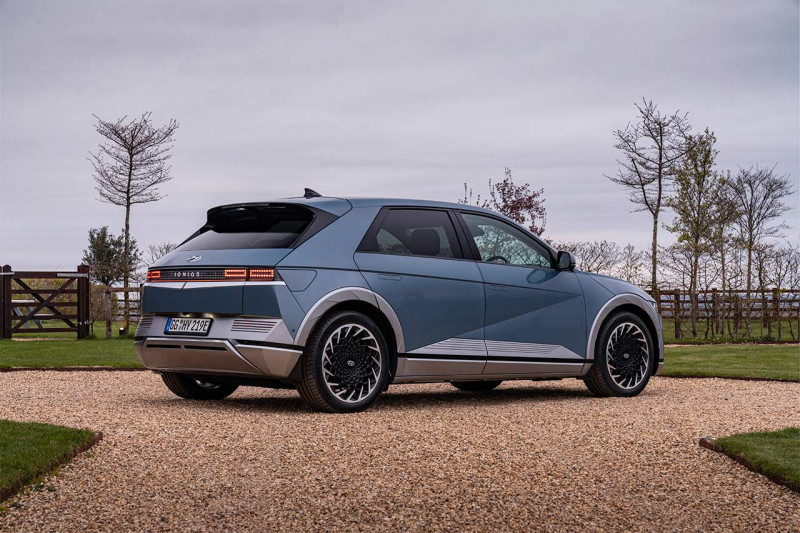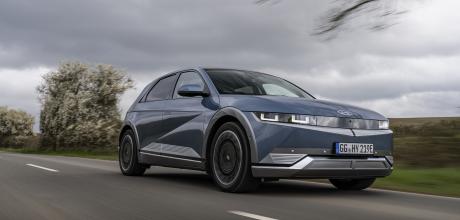2022 Hyundai Ioniq 5 Ultimate AWD
Ever since Boris Johnson announced his shocking vision for pure electric mobility last year, with the UK banning the sale of pure petrol and diesel cars from 2030, every car maker around the world has jumped on the bandwagon, announcing plans to electrify their model line-up. While that’s hardly surprising, in a me too, kind of way, companies like Hyundai were already ahead of the curve. At a time when some manufacturers are announcing future plans, cars like the Ioniq 5 are already here.
If you think you may have heard the name before, you’re right, as Hyundai has had a car named Ioniq in its range since 2016. Previously it has been a quirkily styled Focus-sized hatchback with hybrid, plug-in hybrid and pure electric drivetrains. This time around, Hyundai is morphing Ioniq into a sub-brand, with the 5 available to buy now, and the 6 Sedan and 7 SUV set to be unveiled shortly at the Munich motor show. The 5 was previewed by the 45 Concept, and pleasingly, Hyundai’s designers have stayed relatively true to the original design. The new range of Ioniq models will sit alongside other eco-friendly Hyundais, like the Kona Hybrid and Electric and the Tucson and Santa Fe hybrids and plug-in hybrids, as well as the groundbreaking Nexo hydrogen fuel-cell vehicle.

The Ioniq 5 sits on an all-new E-GMP pure electric platform that will underpin future electric cars from the Hyundai, Kia and Genesis brands. Kia’s EV6 is the sister car to the Ioniq 5, though it is beaten into the showrooms. Hyundai will have the first cars at dealers this summer, with Kia following in October. Priced from £36,995, the Ioniq 5 misses out on any kind of subsidy from the Government, following the revision of the scheme in the spring. The newcomer is offered with a choice of two battery packs (58.2 and 72.6kWh), three power outputs (168, 215 and 300bhp), a trio of trim levels (SE Connect, Premium and Ultimate) and a choice of rear- or all-wheel drive.
The entry-level SE Connect wears the £36,995 price tag and features a single electric motor attached to the rear axle. It has a 58.2kWh lithion-ion battery pack, with 158bhp and 258lb ft of torque, while 0-60mph takes 8.5 seconds. There’s a maximum range of 240 miles, with recharging via a 10.5kW charger taking just over 8 hours. A 50kW rapid charger will see 80% restored in approximately 46 minutes while a 350kW charger will replenish in around 17 minutes. Move up to Premium specification and there’s the choice of all three power outputs, with the lower two featuring rear-wheel drive and the 300bhp version paired to all-wheel drive. The 72.6kWh version packs more punch, with 215bhp and 258lb ft of torque on offer, and a maximum range of 300 miles for Premium models and 281 for the flagship Ultimate. Acceleration to 62mph drops to 7.4 seconds and charging takes a little longer at just under 11 hours using a 10.5kW charger. Hooking up to a 50kW station will take just under an hour, and the 350kW charger takes approximately 17 minutes. The extra oomph of the flagship 300bhp AWD edition means it can accelerate to 60mph in 5.2 seconds, while developing 446lb ft of torque. Range drops down to 287 miles on Premium versions and 268 for the Ultimate. The charging time, though, remains exactly the same as the lower powered 215bhp edition.
One of the Ioniq 5’s party pieces is that it has bi-directional charging, so not only can it return energy to the national grid, but it could also provide electricity to another stricken electric vehicle at speeds of up to 3.6kW. That could be invaluable on a dark night when a friend or relative has run out of charge, and the Ioniq 5 dons a metaphorical superhero cape to rescue them.
With 301bhp available under your right foot, there’s thumping great performance away from the lights, and this seems to be emphasised by the near silence as it wafts up to speed. Place the brake regeneration into its maximum setting and it’s nicely aggressive, allowing you to drive the Ioniq 5 mainly with one pedal. A choice of three driving modes – Economy, Normal and Sport – gives you extra options to fine tune the way the car behaves, though we mostly kept it in ‘Normal’ for the duration of our test. The button sprouts off of the steering wheel and is always at your fingertips. The steering is light enough, with great agility and precision, while the handling through the bends is planted and reassuring. Body lean is neatly contained and while the suspension settings are on the firm side, it soaks up all but the worst imperfections neatly. Thanks to the laminated side windows, refinement is top notch, with low levels of road, tyre and wind noise entering the cabin. Step into the cabin and it’s utterly unconventional, but in a good way. The twin elongated screens have an air of Mercedes-Benz A-Class about them, and yet their execution is fresh and new, maybe because of the choice of background colours. The graphics are super clear, and all of the displays are easy to fathom. We love the way that when you indicate, you get an image on the screen of what the corresponding wheel is up to, so that you can avoid grazing it on an errant kerb.

The dashboard itself is low set, with climate controls separate from the touchscreen, flanked by shortcuts for the audio system. There’s an air of simplicity to the design, and yet it’s quite intricate, all at the same time. The gear selector is attached to the steering column on the right-hand side, and it’s a surprisingly natural place for it to be. It certainly frees up space in the centre of the car, where Hyundai has positioned a pair of cupholders and lots of storage. Oddments are well catered for, even though the door bins are relatively modest. There’s a decent amount of space in the centre console, a drawer-like glovebox and various charging options available for different devices. There’s a mix of different quality plastics, though, from hard scratchy to plush padded.
Brush the centre of the steering wheel, where the horn push is, and it’s covered in a textile, rather than the more traditional plastic or leather. It’s oddly pleasing for being different. The flat-bottomed steering wheel is nice to hold, with touch sensitive buttons for the adaptive cruise control, telephone, and audio settings. The driving position is set quite high, but even so, there’s lots of headroom both front and back. It’s a similar story for rear leg, knee and foot space, on account of the car’s extra-long wheelbase, with generous proportions for every occupant, even with a glass panoramic roof fitted. While the seats offer good lateral support, the squabs feel quite hard, and may take some bedding in before they are truly comfortable. Move to the business end and there’s a generously proportioned 527-litre boot with a relatively high loading sill, and that extends to 1,587 litres with the seats folded down. The rear chairs slide forward and aft so that you can prioritise carrying capacity over leg room.
Standard equipment on all versions includes 19-inch alloy wheels, dual-zone climate control, a rain sensor, sliding rear seats, LED headlights, power folding mirrors, drive mode selector, rear parking sensors and a reversing camera. Other equipment includes adaptive cruise control, keyless entry and start, a 12.3- inch touchscreen with navigation system, wireless smartphone charging and Android Auto and Apple CarPlay. For safety, autonomous emergency braking, lane keep and follow assist and seven airbags are provided, including one for the centre of the car. Premium versions add an electric driver’s seat, heated front seats, an auto-dimming rear-view mirror, heated steering wheel, front parking sensors, electric tailgate and blind spot warning. At the top of the range, Ultimate versions include alloy sports pedals, an electric front passenger seat, cooled front seats, heated rear seats, leather upholstery, rear privacy glass, laminated side windows, headup display and a Bose premium audio system with seven speakers and subwoofer. 20-inch alloy wheels are fitted to all 72.6kWh Ultimate models.
FACT & FIGURES
- On sale — Now
- In showrooms — Summer 2021
- Prices — £36,995 to £48,145
- Bodystyles — 5-door crossover
- Engines — Electric automatic (168bhp),
- Electric automatic (215bhp), Electric automatic (301bhp)
- Trim levels — SE Connect, Premium, Ultimate
- Also consider — Kia EV6, Volkswagen ID.4
- Model tested — Ultimate AWD
- Price — £48,145
- Built in — Ulsan, South Korea
- Codename — NE Platform — E-GMP
- Bodystyle — 5-door SUV, 5-seats
- Layout — Four-wheel-drive
- Powerplant — Electric motor and 72.6kWh lithium-ion battery pack
- Transmission — 1-speed automatic
- Max power (front electric motor) — 94bhp
- Max power (rear electric motor) — 207bhp
- Max power (combined) — 301bhp
- Max torque (front electric motor) — 188lb ft
- Max torque (rear electric motor) — 258lb ft
- Top speed — 115mph 0-62mph — 11.2secs
- CO2 emissions — 0g/km Range — 267 miles
- Recharge time (Domestic socket/10.5kW fast charger/50kW rapid charger/350kW rapid charger)-
- 30 hours 45 minutes/10 hours 53 minutes/56 minutes/17 minutes
- Insurance group — tba
- BIK rate (2021/2022 tax year) — 1%
- Size (length/width without mirrors) — 4,635/1,890mm
- Boot space (min/max) — 527/1,587 litres
- Kerb/max towing weight — 2,020/1,600kg
- Euro NCAP crash rating — Not yet tested
- Warranty – car — 5 years/Unlimited miles
- Warranty – battery — 8 years/100,000 miles
- Wheels (Full-size/spacesaver/run-flats/self-sealing/repair kit) — No/no/no/no/yes
- Verdict — The Ioniq 5 is bold and new, and has an air of modern-day Maestro about it, but in a good way. One of the best ways to make an electric statement.
- DrivesToday rating — 9/10


